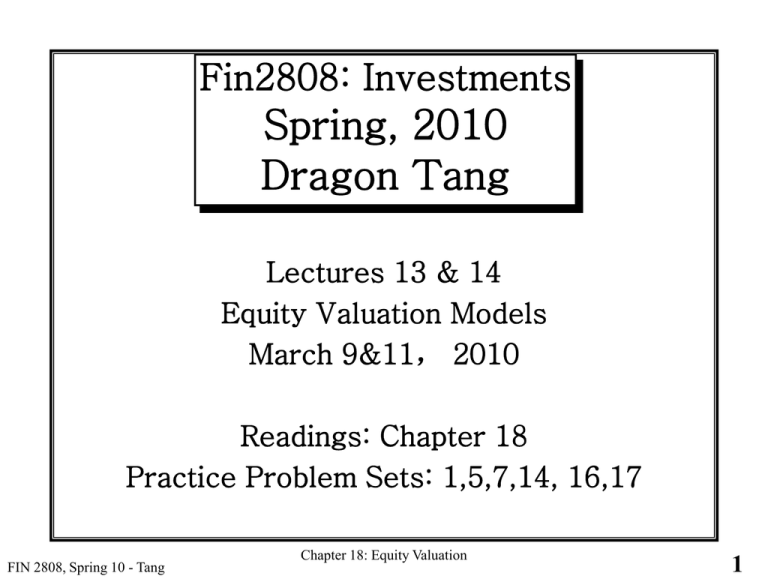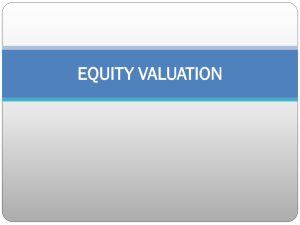Chapter 12 - Equity Valuation
advertisement

Fin2808: Investments Spring, 2010 Dragon Tang Lectures 13 & 14 Equity Valuation Models March 9&11, 2010 Readings: Chapter 18 Practice Problem Sets: 1,5,7,14, 16,17 FIN 2808, Spring 10 - Tang Chapter 18: Equity Valuation 1 How to make money in stocks? FIN 2808, Spring 10 - Tang Chapter 18: Equity Valuation 2 How to make money in stocks? • Capital gains: buy low/sell high – Growth companies • Dividend yields: income stream – Matured (value) companies FIN 2808, Spring 10 - Tang Chapter 18: Equity Valuation 3 Equity Valuation Objectives: • Calculate the intrinsic value of a firm using either a constant growth or multistage dividend discount model. • Calculate the intrinsic value of a stock using a dividend discount model in conjunction with a price/earnings ratio. • Assess the growth prospects of a firm from it P/E ratio. FIN 2808, Spring 10 - Tang Chapter 18: Equity Valuation 4 Balance Sheet Valuation Methods • Book Value • Liquidation Value • Replacement Cost market price Tobin' s Q replacemen t cost FIN 2808, Spring 10 - Tang Chapter 18: Equity Valuation 5 Expected Holding Period Return E(HPR) E D1 E P1 P0 P0 E D1 E P1 P0 P0 P0 expected expected dividend capital gain/loss yield yield • If E(HPR) > Required Rate of Return(RRR), the stock is a good deal. • RRR is from a pricing model, e.g. CAPM: E (rXYZ ) rf XYZ ( E (rm ) rf ) •In market equilibrium, E(HPR) = RRR. FIN 2808, Spring 10 - Tang Chapter 18: Equity Valuation 6 Intrinsic Value versus Market Price Intrinsic value --The present value of a firm’s expected future net cash flows discounted by the required rate of return. E ( D1 ) E ( P1 ) V0 1 k •V0 (intrinsic value) > P0 (market price) buy •V0 (intrinsic value) < P0 (market price) sell or sell short •In market equilibrium, V0 = P0 •k is the market capitalization rate which equates V0 and P0 •If V0 P0, then EMH implies the estimate of k is wrong FIN 2808, Spring 10 - Tang Chapter 18: Equity Valuation 7 Dividend Discount Models One Period Case: E ( D1 ) E ( P1 ) V0 1 k Multi-period Case: D1 D2 DH PH V0 ... 2 H 1 k 1 k 1 k Where D1,…, DH and PH are expected values FIN 2808, Spring 10 - Tang Chapter 18: Equity Valuation 8 Dividend Discount Models Example: Whitewater Rapids Company is expected to have dividends grow at a rate of 12% for the next three years. In three years, the price of the stock is expected to be $ 74.46. If Whitewater just paid a dividend of $2.00 and its level of risk requires a discount rate of 10%, what is the intrinsic value of Whitewater stock? FIN 2808, Spring 10 - Tang Chapter 18: Equity Valuation 9 Dividend Discount Models Dividend discount model (infinite horizon): D3 D1 D2 V0 ... 2 3 1 k 1 k 1 k FIN 2808, Spring 10 - Tang Chapter 18: Equity Valuation 10 Constant Growth DDM (Gordon’s Model) D0 1 g D0 1 g D0 1 g V0 ... 2 3 1 k 1 k 1 k 2 D0 1 g D1 V0 , kg kg FIN 2808, Spring 10 - Tang Chapter 18: Equity Valuation 3 gk 11 Constant Growth DDM Example: Whitewater Rapids Company is expected to have dividends grow at a constant rate of 6% for the foreseeable future. If Whitewater just paid a dividend of $2.81 and its level of risk requires a discount rate of 10%, what is the intrinsic value of Whitewater stock? FIN 2808, Spring 10 - Tang Chapter 18: Equity Valuation 12 Market Capitalization Rate D1 Gordon’s Model: V0 k g If V0 = P0 : D1 k g P0 Dividend Capital Yield Gains Yield If g = 0: D0 1 g D0 1 0 D1 V0 kg k 0 k Perpetuity FIN 2808, Spring 10 - Tang Chapter 18: Equity Valuation 13 Implications of this Model D1 V0 k g • If D1 increases, then V0 increases. • If k decreases, then V0 increases. • If g increases, then V0 increases. • If D1 increases X%, then V0 will increase X%. • g = the capital gains yield FIN 2808, Spring 10 - Tang Chapter 18: Equity Valuation 14 Dividend Payout Ratio and Plowback Ratio • Dividend Payout Ratio: Percentage of earnings paid out as dividends • Plowback (or Earning Retention) Ratio: Fraction of earnings retained and reinvested in the firm FIN 2808, Spring 10 - Tang Chapter 18: Equity Valuation 15 Stock Prices and Investment Opportunities • If a firm retains earnings and reinvest them in a profitable investment opportunity, dividend may grow “faster”. • If a firm pays out all dividends nothing gets re-invested, nothing growths. FIN 2808, Spring 10 - Tang Chapter 18: Equity Valuation 16 Figure 12.1 Dividend Growth for Two Earnings Reinvestment Policies FIN 2808, Spring 10 - Tang Chapter 18: Equity Valuation 17 Plowback Ratio and Growth g ROE b Where: ROE = Return on Equity b = Plowback Ratio (or Earning Retention Ratio) FIN 2808, Spring 10 - Tang Chapter 18: Equity Valuation 18 Stock Prices and Investment Opportunities D1 E1 ( 1-b) P0 k g k-(ROE b) E1 P0 PVGO k Present value no-growth (b=0 or ROE=k) FIN 2808, Spring 10 - Tang Present value of growth Opportunities PVGO > 0 if ROE>k PVGO <0 if ROE<k Chapter 18: Equity Valuation 19 Estimating Growth Example: Takeover Target has a plowback ratio of 60% and an ROE of 10%. If it expects earnings to be $ 5 per share, what is the present value of Takeover’s growth opportunities if the appropriate capitalization rate is 15%? What is the PVGO? FIN 2808, Spring 10 - Tang Chapter 18: Equity Valuation 20 Life Cycles and the Constant Growth Model Changing growth rates: D1 D2 DH DH 1 V0 ... . .. 2 H H 1 1 k 1 k 1 k 1 k temporary high (or low) growth FIN 2808, Spring 10 - Tang permanent constant growth Chapter 18: Equity Valuation 21 Changing Growth Rate Example: Whitewater Rapids Company is expected to have dividends grow at a rate of 12% for the next three years. In three years, the dividends will settle down to a more sustainable growth rate of 6% which is expected to last “forever.” If Whitewater just paid a dividend of $2.00 and its level of risk requires a discount rate of 10%, what is the intrinsic value of Whitewater stock? FIN 2808, Spring 10 - Tang Chapter 18: Equity Valuation 22 Price-Earning (P/E) Ratios • Ratio of Stock price to its earnings per share • Useful for firm valuation: P P E E • Problems: – Forecasts of E – Forecasts of P/E FIN 2808, Spring 10 - Tang Chapter 18: Equity Valuation 23 P/E Ratios and Growth E1 P0 PVGO k P0 1 PVGO 1 E E1 k 1 k E1 If PVGO = 0: P 0 k FIN 2808, Spring 10 - Tang Chapter 18: Equity Valuation 24 Numerical Example: No Growth E0 = $2.50 g=0 k = 12.5% P0 = D/k = $2.50/.125 = $20.00 P/E = 1/k = 1/.125 = 8 FIN 2808, Spring 10 - Tang Chapter 18: Equity Valuation 25 P/E Ratios and ROE P0 1 b E1 k ROE b P/E ratio rises with ROE but not necessarily with b P/E ROE>k 1/k b ROE<k FIN 2808, Spring 10 - Tang Chapter 18: Equity Valuation 26 Numerical Example with Growth b = 60% ROE = 15% (1-b) = 40% E1 = $2.50 (1 + (.6)(.15)) = $2.73 D1 = $2.73 (1-.6) = $1.09 k = 12.5% g = 9% P0 = 1.09/(.125-.09) = $31.14 P/E = 31.14/2.73 = 11.4 P/E = (1 - .60) / (.125 - .09) = 11.4 FIN 2808, Spring 10 - Tang Chapter 18: Equity Valuation 27 Figure 12-3 P/E Ratio of the S&P 500 Index and Inflation FIN 2808, Spring 10 - Tang Chapter 18: Equity Valuation 28 Caveat with P/E Ratios • High plowback ratio (b) (g = ROE*b) High Growth Rate (g) BUT • High g (if due to high b) High P/E ratio • Practitioners: high P/E as proxy of high dividend growth (g) FIN 2808, Spring 10 - Tang Chapter 18: Equity Valuation 29 P/E ratio and Risk P 1 b E kg Holding everything equal: High risk (k), Low P/E. Why do small-risky firm have high P/E? FIN 2808, Spring 10 - Tang Chapter 18: Equity Valuation 30 Pitfalls in P/E Analysis • Earnings are based on accounting data Current price and current earnings Future expected earnings is more appropriate • In P/E formula, E is an expected trend • In financial pages, E is the actual past period's earnings FIN 2808, Spring 10 - Tang Chapter 18: Equity Valuation 31 Figure 12-6 P/E Ratios FIN 2808, Spring 10 - Tang Chapter 18: Equity Valuation 32 Combining P/E and DDM D4 P E EPS D1 D2 D3 V0 2 3 4 1 k 1 k 1 k 1 k FIN 2808, Spring 10 - Tang Chapter 18: Equity Valuation 33 The Aggregate Stock Market: Earning Multiplier Approach VM P E E where P/ E 1 E P and E P is the earnings yield FIN 2808, Spring 10 - Tang Chapter 18: Equity Valuation 34 Other Valuation Ratios & Approaches • • • • Price-to-book Price-to-cash flow Price-to-sales Present Value of Free Cash Flow FIN 2808, Spring 10 - Tang Chapter 18: Equity Valuation 35 Summary • Valuation approaches: -Balance sheet values -Present value of expected future dividends • DDM states that the price of a share of stock is equal to the present value of all future dividends discounted at the appropriate required rate of return D1 V • Constant growth model DDM: 0 kg • P/E ratio is an indication of the firm's future growth opportunities • Models used for the firm can be used to forecast the behavior of the aggregate stock market FIN 2808, Spring 10 - Tang Chapter 18: Equity Valuation 36







